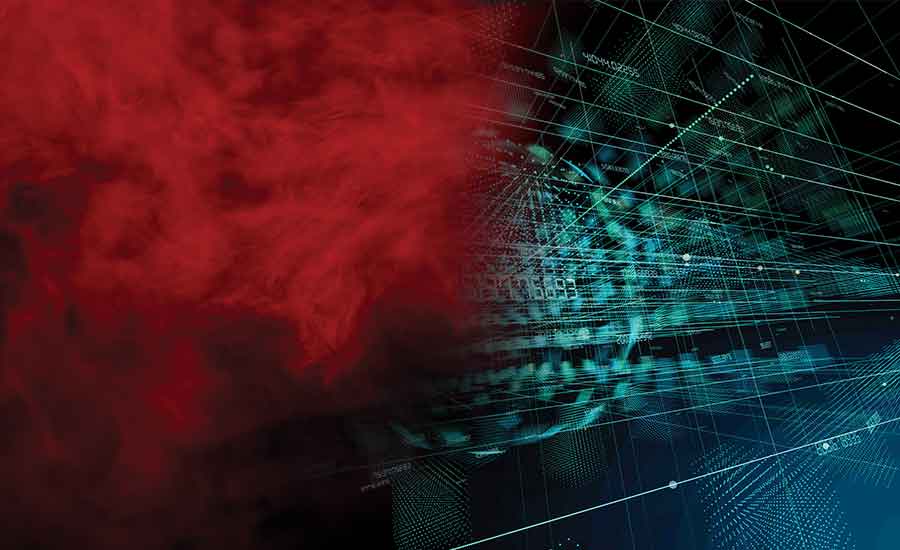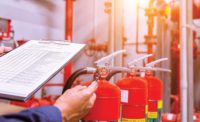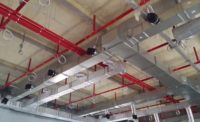Picking up from my last article, “Smoke Control Infrastructure Pitfalls” (December 2018), we will explore some context for real-world smoke control applications with a focus on using NFPA 92 as a resource for your smoke control rational analysis development in this article. We will do so with an eye toward looking past some typical design shortcuts that will amount to failure in practice. In other words, we’ll go a little deeper into developing the discipline needed to avoid the propensity for wishful thinking in the world of smoke control design and commissioning.
Wishful Thinking
We can start off our exercise in avoiding wishful thinking with perhaps the most fundamental mistake of practical smoke control design — the assumption that shaft pressurization applications, e.g. exit stairs and elevators, are the simplest and easiest and thus require the least amount of effort. In my experience, in practice, this oversimplification can often result in real-world performance problems.
Designers can easily be caught up in the calculations: design fires, pressure and flow calculations, and more from NFPA 92. The standard covers so much more though, and some of these critical elements of design can easily fall through the cracks.
Wishful Thinking Case No. 1:
You won’t need barometric or bypass relief because your pressurized shaft design (stair or elevator) is based on VFDs to modulate the shaft injection air.
VFDs are control devices that must be supervised for faults (Section 6.4.5.4.3), positively verified for status (Section 6.4.8.2), and under no circumstances be permitted to over-pressurize exit doors (Section 8.4.4.6) or interfere with elevator car operation (Section 8.4.4.8).
VFDs are required to have a “fire mode” where the device runs to 100% capacity. Your design must accommodate this. Your shaft cannot over-pressurize during this condition. Do not rely upon VFDs alone. If your fan selection allows for conditions that would render the doors inoperable due to excess opening force or excess air velocity effects when the VFD is running at full output, then you must include properly sized relief, even where the local building code does not prescriptively require shaft venting or relief. An increasing reliance on VFD controllers with uncompensated relief can be detrimental to effective shaft pressurization, as we are driven to make more concessions to energy efficiency. More comprehensive guidance on dealing with these adverse effects in elevator shafts can be found in the Annex Section A.4.7, NFPA 92. The omission of the vent for elevator hoistways has some practical and life safety constraints that are supposed to be dealt with by the smoke control rational analysis but generally are aligned with the common use of VFD lift controllers these days. Let me just say, I’ve seen a lot of VFD controllers fail, default, or overspeed in general use let alone in life safety use with varying degrees of adverse consequences … hence the following thoughts. Mind you, I am switching between VFD applications along the discussion.
FIGURE 1. Configuration options for proper excess pressure relief.
First, let’s examine the piston effect. For any single car within an isolated shaft — anything other than low-speed lift control, e.g. a hydraulic drive — you will have adverse piston effect. For multiple cars in a common shaft with high-speed control, you may still need to consider piston effect if the controls allow simultaneous upward motion with insufficient clearance around the cabs to dissipate that pressure. This issue actually applies to normal operational concerns as well as during a fire. For any configurations other than open lobbies, the lobby enclosures will further reduce the ability to dissipate shaft pressure.
Alternatively, pressurized elevator shafts will at the very least need a barometric relief vent, even if a VFD fan drive is involved (life safety demands minimally acceptable performance under 100% drive conditions). I’ve seen elevator doors fail when sensors cannot read a “closed” position due to excess air velocity effects, thus preventing recall and other life safety functions during smoke mode, all because the design made no provision for venting excess pressure.
In summary, tread lightly to “no vent” just because they’ve dropped the mandatory vent language in the local building code. Deferring to smoke control design means excess pressure conditions must still be addressed, even if it occurs under another name. Designers should perhaps consider some specification language along the lines of deferring to the smoke control rational analysis for vent sizing, especially if it’s being performed by others — better yet, provide a drawing note to flag it clearly.
I simply cannot count the number of times I’ve seen a VFD in default mode because power outages lost volatile memory, reset, or other changes that occurred after original commissioning. These conditions will not report through the VFD controller as a fault to the smoke control system.
And if the design relied solely on VFD modulation of fan output to prevent over- pressure conditions inside the shaft, the stair and elevator doors are consistently inoperable in these cases. Had it been an actual fire emergency, these shafts would have been nonfunctional for both occupant egress and emergency responders. These systems were designed to failure. If you think periodic inspection, testing, and maintenance for smoke control systems are excessive or unnecessary — and you aren’t going this deep in your periodic testing — you’re missing a crucial and essential point. Supervising and exercising the equipment without measuring crucial endpoint performance is inspecting to failure.
New and revised language in the 2018 edition of NFPA 92 addresses these kinds of failure scenarios more directly. Weekly self-testing of the smoke control system from Section 6.4.8.6 defers to normal building operations. This kind of exemption can be pragmatically expected to become the norm, considering how quickly smoke control systems can deplete environmentally controlled air during these tests. Weekly testing that places air conditioning equipment outside of its design specifications regularly will cause more than a creature comfort issue for the building occupants. New language from Section 6.4.8.7 addresses these expected exemptions by implementing mandatory semiannual operational testing of the smoke control system. More comprehensive guidance on designing adequate relief air is found in Annex F, NFPA 92. Ensuring life cycle performance is up to you.
Wishful Thinking Case No. 2:
You won’t need Duct B (ISO 6944)/Conditions C and D (ASTM E2816) fire-rated duct in your stair and elevator pressurization design because AC 179 says there are exemptions for Duct A (ISO)/ Conditions A and B (ASTM). Well, AC 179 also says you must apply all pertinent paragraphs to your design. Unless you’re designing to failure, you’re omitting fire dampers where the pressurization duct penetrates the shaft wall. If you understand the testing criteria, the unexposed side of the duct (interior in this case) passes at 325ºF above ambient. So, considering an ambient temperature around 75º, that duct passes at ~400º on the interior. Your standard fire dampers are triggered at less than half that temperature. Fire dampers listed to ANSI/UL 555, Standard for Safety Fire Dampers, have a maximum link temperature of 286º (Reference NFPA 90A, Section 5.4.5.2.2.1). FIGURE 2. Required duct fire resistance - fire outside.
FIGURE 2. Required duct fire resistance - fire outside.
Other high-temperature fire dampers are still triggered at well less than the allowable temperature expected on the unexposed side of these fire-rated ducts. If your damper closes doing exactly what it is designed to do, at the temperatures it is supposed to do so, and it inherently defeats your pressurization fan completely, then you’ve designed to failure. The proper design is to omit these dampers because you are instructed to omit dampers that will interfere with your smoke control system, and because you should be using the correct kind of fire rated-duct. Omitting that unnecessary and interfering fire damper triggers paragraph 3.6 of AC 179 … which then demands Duct B (ISO)/Conditions C and D (ASTM). One last point on this front, by reference from both the building code and NFPA 92, we find NFPA 90A gives us specific language that reinforces this concept — the fundamentals of fire resistance always apply.
Clearly, stair and elevators shafts are “shafts,” so NFPA 90A Section 5.3.4 applies. If four or more stories are involved, 5.3.4.3 applies, which makes clear a minimum two-hour fire-resistance rating must address fire exposure from both the inside and outside. And if you’re using a fire-rated duct as both enclosure and duct, then Section 5.3.4.4 demands the fire-rated duct fully meet the criteria for a duct under Section 4.3 while also fully meeting the fire resistance from 5.3.4.3. Your pressurization ducts serving these shafts are extensions of the shaft’s fire-resistive rating all the way to the exterior intake louver. There is no exception for fire-resistance performance from the fire inside exposure in NFPA 90A. This is much clearer than the somewhat confusing ‘option’ from AC 179. What do you do when NFPA 90A and other criteria all apply? You use the more restrictive criteria. Make no mistake, the language in 5.3.4.3 and 5.3.4.4 correlate only to Duct B (ISO)/Conditions C and D (ASTM). As for the argument that, pragmatically speaking, direct fire effects can never reach the inside of such pressurization ducts, take note — the language in Section 5.3.4 of NFPA 90A makes no such allowance. There are reasonable fire temperature and pressure effects from transient activities that might occur inside exit stairwells. These are not to be dismissed, otherwise the stair shaft wall itself would have no rating from the interior, and NFPA 90A would not be so explicit. Furthermore, consider historical high-rise fire incident data for external cladding fires. The intake for such pressurization ductwork becomes just as much a concern for fire scenarios for which pressurization is fundamentally intended to protect the shaft. If the system has been designed with such fire dampers, those dampers will operate as designed and render the system nonoperational in those cases.
FIGURE 3. Required duct fire resistance - fire inside.
How far into a zero-hour fire-rated duct (Duct A) must any fire effects extend before risking failure? And for how long of an exposure before that zero-hour fire-rated duct risks failure? If you’re asking these questions, you’ve missed the point and designed to failure. NFPA 92 Sections 4.2.3 and 6.6.3 require all smoke control system infrastructure be designed for their probable fire exposures. This covers all likely scenarios and not just the easy fire scenarios. NFPA 90A makes clear those scenarios are to include fire exposures from both inside and outside the passive fire resistive assemblies, whether by means of built enclosure or fire-rated ducts. More on that next time.






